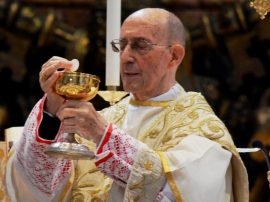Join Our Newsletter
Receive the latest info on exclusive offers, seasonal deals, and exciting new arrivals.


No reviews yet. Write review.

This item will earn 25 loyalty reward points. Learn about loyalty points >
With
a Preface by Bishop Athanasius Schneider
2018 218
pages hardcover $18.00 #63233
From the Preface of Bishop Schneider: “The Church in our times has the urgent need of courageous voices
in defense of her greatest treasure, which is the mystery of the Eucharist.
Often today there arise voices in defense of the many human and temporal needs,
but rare are the voices that defend the Eucharistic Jesus. With his book Communion
in the Hand, His Excellency Most Rev. Juan Rodolfo Laise, Bishop Emeritus
of San Luis (Argentina), has for several years raised his voice in defense of
the Eucharistic Lord, showing with convincing argumentation the inconsistency
of the modern practice of Communion in the hand from a historical, liturgical
and pastoral perspective...  I consider it an honor and joy to
be able to present this book of the most worthy Bishop Juan Rodolfo Laise, “decus
episcoporum Argentinae.” I hope this prophetic voice of an elderly bishop,
who has retained his youth and purity of faith and reverent love for the
Eucharistic mystery, may enkindle readers with the same faith and the same love
and contribute to the universal restoration of the more sacred and reverent
manner of receiving the Lord’s Body.”
I consider it an honor and joy to
be able to present this book of the most worthy Bishop Juan Rodolfo Laise, “decus
episcoporum Argentinae.” I hope this prophetic voice of an elderly bishop,
who has retained his youth and purity of faith and reverent love for the
Eucharistic mystery, may enkindle readers with the same faith and the same love
and contribute to the universal restoration of the more sacred and reverent
manner of receiving the Lord’s Body.”
Bishop
Laise was born on February 22, 1926 in Buenos Aires. He entered the Capuchin
Order, in which he received priestly ordination in 1949 when he was only
twenty-three years old. Later he obtained his licentiate in canon law from the
Gregorian University in Rome, and his doctorate in civil law from the national
university of Córdoba (Argentina). In 1969 he was named Provincial Superior of
the Capuchins of Argentina.
Since the beginning he made his priority the care of vocations: their number, and above all their solid formation, creating in 1980 the diocesan seminary “St. Michael the Archangel.” Thirty years later, when he turned seventy-five and had to leave his diocese, there were more than fifty seminarians, and a young and numerous clergy who worked actively in the towns and villages of the province. Similarly, he promoted the installation of various religious congregations. Since the beginning his activity has been multiple and incessant: the foundation of religious houses, of schools, of a Catholic University extension, numerous churches and chapels for the new districts of a province whose population is constantly growing, and the organization of congresses and conferences. The apostolic directives followed one another, in the spirit and decisions of Bishop Laise, at a feverish pace. However, as a Capuchin religious he knew well that activity, even the most noble one such as that of the apostolate, is not fruitful if it does not nourish its roots in contemplation. That is why he also encouraged the establishment in the diocese of contemplative communities.
But if in anything he has stood out in a special way, it has been in his Eucharistic piety and devotion, which have been translated in a special way into the Adoration of the Blessed Sacrament – which by his express will has been exposed throughout the day in the diocesan Cathedral since the 1980s – and in his care for the organizing of the feast of Corpus Christi, with a procession of the Blessed Sacrament through the streets of the city, and in his homilies for the occasion.
For all these reasons it is understandable that when, in 1996, he found himself confronted with a responsibility, that of making a decision about the possibility of resorting to an indult to give Holy Communion in a less devout manner – which makes less clear the Real Presence and the Priesthood, and which furthermore was obtained through a frontal disobedience to the Pope – he did not ask to avail himself of this, and, in the same way, he more recently has reacted to the possibility of giving Communion to someone who is not in the state of grace. After his retirement in 2001 he returned to the Franciscan conventual life and he chose the Shrine of Padre Pio in San Giovanni Rotondo (Italy), where is found the saint’s venerated tomb. There he spends the mornings hearing the confessions of the pilgrims. He often agrees to travel to occasionally collaborate elsewhere, having performed numerous ordinations for various religious congregations, and accompanied pilgrims to Lourdes, Rome, etc., during these nearly two decades. In the photo on the back of the dust jacket of the book, he is seen on one of those occasions, celebrating a Pontifical Mass on the Altar of the Chair of St. Peter in the Vatican Basilica on October 24, 2015.
Copyright © 1996-2025 Sunrise Marian. All rights reserved.